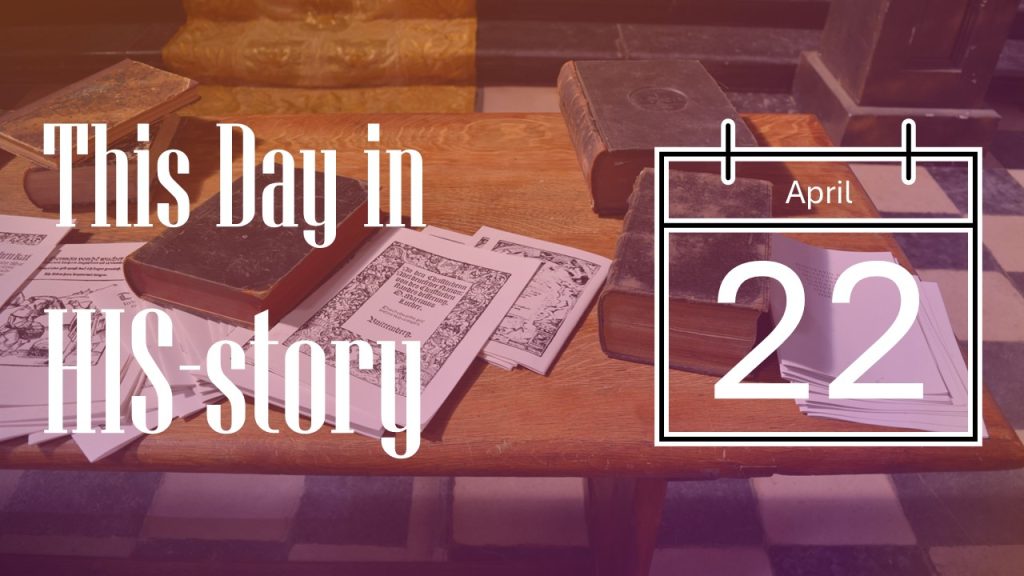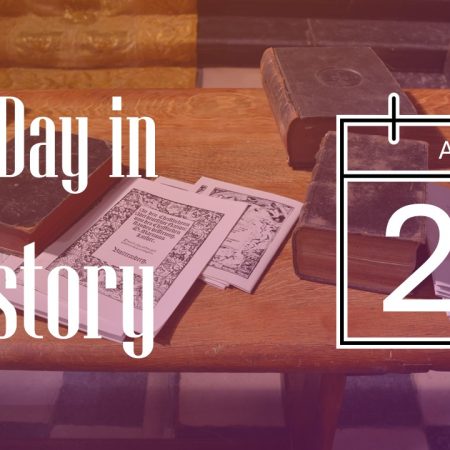
1538
John Calvin and William Farel are fired by the town council of Geneva and ordered to leave the city within three days. They had refused to administer the Lord’s Supper the day before in part because of notorious sins among the city’s folk, and in part because they did not want to follow the lead of Bern in serving unleavened bread.
1922
It was in 1878, in the town of Issele-Uku in Benin Province, Asaba Division, Delta State, Nigeria, that Olisemeke Nwadiei Nwaonya was born. This baby was later to become Samuel W. Martin. He was born into the aristocratic family of Papa Nwadiei Nwaonya, and his mother was from a royal family. Martin had one full brother and one full sister and many half-brothers and sisters, as his father had eight wives.
Martin’s parents were pagans and his father initiated him into the pagan cult because it was considered disgraceful and disloyal to abandon the traditional faith. Martin was therefore educated in his father’s cult, which was a branch of the town cult, and through that, he learned the art of fortune-telling and many other practices.

Martin desired to go to school, so he left home in search of knowledge. He went to Umuashia, near Lokoja, and became a steward to an American missionary of the Sudan Interior Mission, the late Rev. A. E. Martin. It was there that he came to know the Lord Jesus as his Savior. When Rev. Martin was to return to the U.S. on leave, he planned to leave him behind, but Samuel kept on requesting that he be allowed to follow his new friend to the foreign land. Martin eventually agreed for Samuel to go with him, and as God would have it, Samuel – who had never been to school a day in his life – found himself in America, where God prepared him for the future. [1]. When they arrived in America, Martin paid for Samuel’s tuition for one year and then left, and they never saw each other again. However, in gratitude, Samuel adopted the name “Martin” as his surname and from then on he became known as Samuel Wadiei Martin. [2]. Samuel Martin spent thirteen years in an industrial and educational Institute and graduated with honors, becoming an excellent carpenter, mason, blacksmith, tailor, and teacher.
Call to Ministry
Most importantly, Martin found out what it really meant to become a Christian, and he became a member of the Shiloh Baptist Church in Topeka. While attending school and working in this church he felt a very strong call from God to become a minister. He left for Chicago University for six months and later enrolled in Moody Bible Institute for additional study. While in Chicago, Martin became one of the charter members of the Pilgrim Baptist Church, and he was ordained there in 1920.
In 1921, God began to tug at his heart again and he was reminded of his people in Issele-Uku, who had a great need for the gospel. In 1922, when Martin was to leave the United States, the “Rope Holders Club” of Pilgrim Baptist Church in Chicago pledged to give him financial aid in his work in West Africa. When Martin got back home, he found that his hometown of Issele-Uku looked like an overgrown farm, with paths running through the thick jungle to a new road. The town he had thought to be very beautiful before he left for the United States now looked very discouraging to him. However, Martin was not discouraged by the disparity between America and Nigeria, even though conditions in Nigeria were quite strange to him after such a long absence. At once, Martin started to make plans to make Issele-Uku his home again.
On his return to his native land he had the intention of founding a Baptist church, a day school, and an industrial institute. He had accumulated some savings while he was in America, and he was counting heavily on the help of the “Rope Holders Club” in his home church in Chicago. On this day, 22 April 1922 he eventually started the school, which was initially a thatch house that was built for him. For furniture, he had a table and a chair. Bahama grass was strewn on the table, over which two mats that served to soften the bed were placed, which took the place of a mattress. At night there were snakes and other poisonous reptiles nearby, but God’s providence saw him through.
Martin later realized that his small savings and the gifts of the people in the church were insufficient for the work he wanted to do. In 1924, he returned to the United States for nine months, seeking funds from friends in Pilgrim Baptist Church and other churches. Martin also entered into a contract with the National Baptist Convention [Negro] in America, to become their missionary, and they promised to support him financially so that he could set up a mission in his area. In 1925, when Martin returned from America, the new converts in Issele-Uku started to erect their first church building. Ironically, this building was demolished because of Catholic opposition. In 1927, a larger and more beautiful building was erected, and it was dedicated in 1928. In that same year, the Issele-Uku Baptist Church became a member of the Nigerian Baptist Convention.
In his early work, Martin was the only teacher and pastor. Later, he trained others by sending them to the Baptist College in Ogbomoso. For many years no help came from America, and Martin maintained himself and the work with the proceeds from his farm. Thus, from a humble beginning, God richly blessed the efforts of his servant. Today, in Issele-Uku and the region, there are many Pilgrim Baptist churches and schools, including a hospital. All these achievements were the result of Martin’s great sacrifice, dedication, patience, and his teaching and preaching of the word of God.
Marriage
Although Martin was preaching and trying to win his people to Christ, the people were slow to turn from their idol worship. A young woman was the first person to give her life to Christ, and in 1923, Martin married her. She taught Martin his own language, and he taught her English. Although Martin and his wife were not blessed with children, they did not revert to consulting native doctors in order to get children, as some people did. They lived by example before their people and they were spiritual parents to many.
Martin contributed greatly to the geographical expansion of God’s work in Delta State. He also taught the dignity of labor by his words and deeds. In the area of evangelism he was the first among equals because his evangelism was also done by the example of practical Christian living. This is another reason why his life had such a positive effect on so many people for Christ.
Martin died in 1975 at the age ninety-seven. Although he is now dead, he is alive in the hearts and lives of many people today.
1987
J Edwin Orr died unexpectedly on this day, April 22, 1987, in Asheville, North Carolina. The 73-year-old historian was scheduled to speak at a Southern Baptist convention in the city.
Historians aren’t always the speakers you expect to attract large audiences. But Orr’s expertise was in high demand with churches. For many years an evangelist, he was also a historian of revival–the spiritual renewal of churches. He amassed fascinating anecdotes and worthwhile details about these spiritual movements and incorporated them into talks and books.

Born in 1912 in Belfast, Ireland, Orr became a Christian at nine. Some years later, his father died, and then an older brother. Orr had to leave college to work as a clerk in a bakery to feed the rest of the family. He was about 19 when he and a friend began evangelistic work, preaching in the open air in Belfast.
One thing led to another, and Orr became convinced he must become a traveling evangelist. He made contacts in London and soon was preaching across Britain. By 1935, he was touring Scandinavia and much of Europe. Later that year and into 1936, he sailed to Canada for meetings and held more in the United States, New Zealand, Australia, and Africa, concluding the flurry of services in Norway.
He hoped to rest, but local leaders appealed to him to lead services for them. He did. Meanwhile, he telegraphed a young woman he had met in South Africa and asked her to marry him. Muriel Carlson agreed. They held an evangelistic service at their reception!
Orr went on to form an evangelistic group and turned out numerous books–sometimes two a year–recounting his experiences and showing how to live the Christian life. In the United States, he picked up a theology degree before enlisting as an Airforce chaplain. He saw service in the Pacific and wrote a book about that, too.
After hitchhiking home across Asia and Africa, Orr returned to England, where he took his doctorate at Oxford University. His dissertation was on one of the great revivals of history: The Second Evangelical Awakening in Britain.
Researching revival, Orr found that each one had begun with prayer. For example, in the Cane Ridge revival, James McGready “was such a man of prayer that not only did he promote the concert of prayer every first Monday of the month, but he got his people to pray for him at sunset on Saturday evening and sunrise Sunday morning. Then in the summer of 1800 come the great Kentucky revival. Eleven thousand people came to a communion service. McGready hollered for help, regardless of denomination.”
Orr also taught that Christians must repent if revival is to flower. “Little by little, the church loses its grip on essential things, becomes a social club, goes to sleep or flies off at a tangent. All over the world we find sleeping churches, and all round them are the gospel-starved masses. Instead of performing the first thing of importance, evangelizing the masses, they are engaged in a bewildering variety of pastimes–anything but the real thing.”
